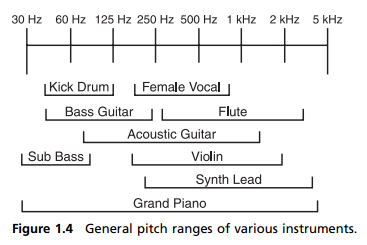Music
Music Theory Basics
Came across a few things while reading about music theory today and thought it might be useful to keep track of some of the basics. …So here goes..
General Pitch Ranges of Various Instruments
Thought it might come in handy later for equalizer config.
Synthesis
In additive synthesis, the required waveform is obtained by adding harmonic waves to a given fundamental. The reverse of this process is called subtractive synthesis. Subtractive synthesis behinds with a waveform rich in harmonic content and then selectively filters out certain frequencies.
The oscillator produces sound in a synthesizer. The oscillator is capable of producing both frequency and harmonic content.
- Sine wave – composed on only one specific frequency.
- Square wave – emphasizes odd-numbered harmonics. Produces a hollow sound. Works well for basses.
- Triangluar wave – emphasizes few specific odd-numbered partials. Produces a clear note, good for imitating sounds of flutes.
- Sawtooth wave – rich in harmonics. Used to imitate string and brass sounds. Common in trance style rich lead synths.
Properties of Sound
Sound Envelope – The way in which a sound develops over time. There are four components: attack, decay, sustain, and release:
- Attack time – time taken for a sound to reach a (maximum) level of loudness.
- Sustain time – time sound remains at a constant level (often maximal).
- Decay time – time taken for sound to fall from sustained loudness to zero loudness.
- Attack / Sustain / Decay defines a sound envelope.
Timbre – created by the kind and number of overtones.
- The tone heard as pitch is called the fundamental tone or the first harmonic of a sound.
- Overtones are additional tones of higher pitch than, and superposed over, the fundamental tone.
- Rich, full sounds (violin, voice) have many overtones, pure, thin sounds (flute, triangle) have few overtones.
Average Tempo Based on Type of Music
- Ambient – 50-100 BPM
- Hip-hop – 70-95 BPM
- Deep House – 110-130 BPM
- Trance – 130-145 BPM
- Hard dance / hardcore – 145-170 BPM
- Drum and bass – 160-180 BPM
Scales
W = Whole step (whole tone), H = Half step (semi-tone)
Major Scale: w-w-h-w-w-w-h (ex. C,D,E,F,G,A,B,C)
Minor Scale: w-h-w-w-h-w-w (ex. A,B,C,D,E,F,G,A)
Note Intervals
The note intervals from 1-12 half-steps:
- minor second
- major second
- minor third
- major third
- perfect fourth
- Diminished fifth
- Perfect fifth
- minor sixth
- major sixth
- minor seventh
- major seventh
- octave
Intervals large than an octave are called compound intervals. This is because they represent a simple interval (12 or less half-steps) plus one or more octaves. For example, an eleventh is also called a compound fourth. To calculate what notes are used in a compound interval, simple take the number, for example, a twentyfourth interval is simply (24 mod 7 = 3) a compound third.
Things to check out
- psychoacoustics – The study of the way in which we hear and perceive sound vibrations.
